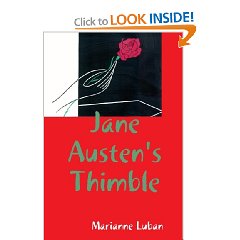This is thanks to Stuart Tyler and his Hatshepsut Project at
http://styler78hatshepsutproject.blogspot.com/2011_09_01_archive.html
Perhaps because the fragment rests in a rather obscure Scottish museum, I had never viewed an image of it and was so surprised and appalled that I asked Stuart if there was any possibility it might be a fake. You can see my conversation with him, as well. But he convinced me it was not and I then realized that, at the time of the building of Hatshepsut's mortuary complex, [ca. Year 7] Thutmose III was supposed to be out of the picture entirely. He really had lost his throne to Hatshepsut's ambitions.
They were not joint rulers at all or Neferura, Hatshepsut's daughter, would have been displayed as a mere princess and not with the diadem and sidelock of an heir apparent--yet another female pharaoh waiting in the wings. During my conversation with Stuart at his site, you can view the URLs to some images of Ramesside Era princes wearing a nearly identical diadem and sidelock.
[click on image for larger view]
There is nothing in existence depicting Thutmose, himself, as a prince. It is scarcely any wonder, then, in light of the above image, that William Petty, in a couple of articles, has pointed out that there are no unambiguous inscriptions of Thutmose III between his Year 5 and Year 13. Where was he and what was he up to? But, sometime after Year 13, Hatshepsut changed her mind and Thutmose began to appear with her on monuments albeit in a secondary position. Then, in her Year 21, Hatshepsut, herself, becomes absent from the record. Under the circumstances, I have to agree with Petty that Thutmose found it convenient to continue the last regnal date of the woman-king. He may have been the rightful sovereign, but it now seems to me he had been deposed, not merely eclipsed, and was not expected to ever resume his kingship during a certain period.
William Petty's paper in the journal, Ostracon, "Redating the Reign of Hatshepsut" can be found here:
http://www.egyptstudy.org/ostracon/vol12_2.pdf
There he gives an account of the items dated to the years of Thutmose III and Hatshepsut, finding a gap of seven for the former.
Addition of October 30: There is however, the problem of Thutmose III being depicted at the mortuary temple of Hatshepsut. According to Alberto Siliotti, construction of the temple of Hatshepsut took fifteen years, between years 7 and 22. Here is where I hit a limestone wall because I have no way of knowing if the depictions of Thutmose are contemporary or retrospective. For example, he is present in a scene commemorating the famous expedition to Punt in Year 9--but in which year was the scene executed? Probably not until at very least Year 10 and by then a co-regency may have been restored. Since I am not familiar with the stages of Djeser Djeseru, I can say no more until I have done more research on the temple.
Tuesday, October 25, 2011
Subscribe to:
Post Comments (Atom)









7 comments:
Thank you Marianne.
This is a very interesting subject area. I hope that you are able to cross- reference your idea with other monumental inscriptions, etc to see if you are able to reach the same conclusion. If you consider continuing with the above, i would be pleased to hear from you(as always). I will share this with others and see what they think.
Certainly, but I think, in general, there has been a good deal of complacency about Hatshepsut to the point where some have made her out to be a benevolent guardian and decided that Thutmose III had nothing against her in the final analysis. This, I might add, shows rather a poor understanding of the oriental male. A Biblical character, mortally wounded by a woman letting fall a millstone upon his head, asked his armor-bearer to kill him so that no one could say he had been bested by a mere female. But, logically, why would Hatshepsut have assumed full pharaonic titles if not to steal the throne of Thutmose III?
The sheer effort of winning a population of ancient Egyptians over to excepting a woman!!!!! as pharaoh even in the guise of step mother, must have been very very hard. But she proved to be better than any male pharaoh, At the death of her husband she may have believed that this was a care taking position. chris
Why do you believe Hatshepsut was a better ruler than Thutmose III in the final analysis?
The more prominent daughters of Ramesses II--Merytamun and Bintanat--are shown wearing the sidelock, as are the princesses (whether they are really king's daughters or stand-ins) participating in the sed festival of Amenhotep III, depicted in the tomb of Kheruef.
This relief of Nefrure, like the rest of the reliefs from the temple of Deir el-Bahri, is a masterpiece--as one German scholar being shown around the temple said, "Wunderbar! Wunderbar!" There is nothing surprising, much less appalling, about it (except for the fact that it was cut out of the wall in the first place).
What I do find surprising and appalling is the complacency of those who cling so hard to the largely discredited reconstruction of history known as 'The Thutmosid feud."
Thutmose III continues his own year dates, of course, because he was never deposed--he was a co-regent all along. Hatshepsut did not steal the throne, and she did not "disappear from history" any more than Horemheb did.
Why is there nothing depicting Thutmose as a prince? Depictions of princes in the Eighteenth Dynasty are fairly rare; and this one succeeded to the kingship as a very young child.
So there's a gap in the records? After thirty-five centuries, is that a surprise? We don't know much at all about Amenhotep III's second decade on the throne, but that doesn't mean anything sinister was going on at the court.
I see a mistake with the assumption that Thutmose III was an Oriental male fearful of being bested by a female. I would argue that Hatshepsut took on the co-Pharaoh role for the purpose to allow Thutmose sufficient time to develop attributes to become a great Pharaoh like her Father Thutmose I, and free him up from the pressure of the ritual duties while overseeing the nomes of Egypt. That is exactly what happened and when on his own he quickly blocked the trouble fermenting in the Levant. It takes a long time for an oak tree to grow tall and strong. Unlike in your novel The Pharaoh's Barber without running away and hiding, he could have sidelined Hatshepsut much earlier with his control of the army. This was much more like the partnership of Alienor of Aquitaine and her son Richard the Lionheart. Now if you made the same claims about Amenhotep II being a typical Oriental male in his view of women, I might have to agree with you.
Richard Paschal
Princesses were not depicted with a diadem and sidelock such as is worn by Neferura. You are thinking of a different kind of sidelock than the "Horus" type depicted on Neferura. Ankhesenamun wore it, too, on a shrine from the tomb of Tutankhamun, and it was among her several hair [or wig] styles. Ankhesenamun had a right to wear the Horus lock. She was a king's daughter and, there being no living offspring of her husband, she was the true heir to the throne.
As to the "feud of the Thutmosids" being a myth--that is only perpetuated by the people who want to view ancient Egypt as a "politically correct" concept. This naive viewpoint completely loses sight of the basic tenet of "where truth and right exist, no lies or propaganda are necessary". Of course, Hatshepsut was not the only royal to enlist Amun in bolstering her own claim to kingship--but, if she was a mere regent for an immature male pharaoh, who planned to step down the moment he reached manhood [which, BTW, is the time of puberty in oriental terms] she would not have:
1. Lied in writing that Amun had declared her to be her father's successor during the time of his festival
2. Lied in writing that she, accompanied by her father, Thutmose I, went to Heliopolis so that Hatshepsut could receive the crown--and was crowned a second time before the members of the court. This was supposed to have happened on New Year's Day and ostensibly made the erstwhile princess a co-king with her father. Later on, the names of Thutmose II were overwritten in this narrative, surely by order of Thutmose III.
3. With these words, written on durable temple walls, hoped to convince readers of the future that she, Hatshepsut, was the one and only true ruler, as ordained by the god Amun and her great father, Thutmose I, and that any males who had claimed kingship in the meanwhile were the usurpers--and not Maatkare Hatshepsut. But females were never supposed to succeed while they had brothers and so Hatshepsut, once she decided to take over, did all she could to wipe out the short reign of her brother Thutmose II, who really was the rightful king.
4. What was the reason Thutmose III, once he grew older, was depicted in a secondary position to Hatshepsut, as though he owed his own kingship to her and not vice versa? That Thutmose III had been king before Hatshepsut is proved by sole attestations of his names very early in his reign. If he was old enough to lead an army by his Year 22, he had been old enough to at least act the part of a king for ritual purposes for years. But how was he supposed to go up against all the men in power who owed all they had to Hatshepsut? "Oak tree" to grow tall and strong, indeed! If Thutmose learned anything from his aunt it was how to scheme and manipulate. And since when is taking candy away from a helpless youngster part of "mentoring"?
Post a Comment